 | ||||||||||||||||||||||||||||||||||||||









|
Crystal Palace Silver Tankard (1871)
|
|||||||||||||||||||||||||||||||||||||
| MUSEUM | FACTFILE |
|---|---|
| Classification | Awards |
| Category | Trophy |
| Artifact | Crystal Palace Silver Tankard |
| Date | 1871 |
| Connection | Crystal Palace Cat Show at Sydenham, London, July 1871. |
| Collection | Civic Insignia and Plate, Lewes Town Council, East Sussex, England. |
| Description | Silver Tankard, by James Chadwick, London, 1700. |
| Brief History | Presented to Harrison Weir by The Crystal Palace Company, 1871 |
| Acquisition | Presented to the Corporation of Lewes, by Harrison Weir, July 31st, 1894. |
 |
Photo by Tom Reeves. Used with permission of the Lewes Town Council, England. |
THE FIRST CAT SHOWS
Although this trophy was never intended as an Award for a winning cat, it is inextricably linked to the one cat show, considered to be the 'premier' event and unequivocal 'beginning' of the modern Cat Fancy.
It has been argued that the July 1871 Cat Show held in the Crystal Palace at Sydenham, London; was not the first of its kind. But that argument is flawed. It is important to acknowledge the parameters of that specific show, and how and why it came into being, and who was instrumental in making it happen, and why those parameters were different to any exhibition or competition between feline exhibits, prior to that date.
Victorian England was, long before 1871, the haven of the Naturalist, and of Natural History studies. There is certainly documentary evidence of exhibitions of cats, conducted by naturalists, and even some where the exhibits competed against each other, with one incident dating from as early as the sixteenth century.
But none of these, nor even those exhibitions pulled together at the Crystal Palace itself prior to 1871, by Mr. Fred Wilson, (who was at that time the Manager of the Natural History Department); were properly competitive 'cat shows', as we understand the term and all that it entails today. In many cases, there were no entry fees paid, there were no breed or variety classifications, or classes established, and certainly no basic written standards by which the exhibits could be measured against or adjudicated.
The idea of an organised Cat Show, run along similar lines to those already well-established for cattle, horse, cage-birds, and more recently dog shows, was mooted first and only by Harrison William Weir; today widely considered as the 'Father of the Cat Fancy'.
THE CRYSTAL PALACE COMPANY
Weir was no newcomer to the world of natural history exhibitions. Like many Victorian gentleman of his era, he was a naturalist through and through. As a young man he very early established a reputation for his knowledge of ornithology, and specifically poultry. His older brother, also an ornithologist and poultry expert, became renown as an entomologist, and for at least three decades or more, both regular judged National exhibitions of cage-birds and poultry. As an artist of considerable natural ability, Harrison Weir had also regularly attended cattle shows, creating images of prize-winning stock for the various periodicals of the times. He was also linked with the London Zoological Society, the Royal Horticultural Society and when it was formed, assisted the Crystal Palace Company, in the laying out of the grounds of the new grounds when the Palace was rebuilt at Sydenham in 1853-54.
Needless-to-say, Weir worked with Mr. Fred Wilson, providing independent expertise for the Natural History exhibitions held at the Crystal Palace, and when Mr. Wilson finally retired in 1877; having completed 25 years in the role of Manager of Exhibitions, Weir acted as Chairperson at one of the ceremonial dinners held in Mr. Wilson's honour.
So, it was perfectly natural that Weir should present his idea for a fully organised Cat Show to the Management of The Crystal Palace Company; suggesting a suitable Entry Fee, a Classification of Varieties and Classes for the same, and providing some basic written Standards by which the qualifying exhibits could be adjudicated. With his connections throughout the wider fancies, he could also draw upon support for the venture from aristocratic circles, from the cage-bird, poultry, pigeon and dog world amongst whom he was already well known.
THE FIRST CRYSTAL PALACE CAT SHOW
To Mr. Wilson, would be left the arrangements to invite, organise and manage the show itself, including the care and welfare of the exhibits during their tenure at the exhibition. The judges chosen for this historic first show were Harrison William Weir, his brother John Jenner Weir and the Rev. J. Cumming Macdona.
However, no-one, not even the management team of The Crystal Palace Company, fully anticipated the level of public support for the Cat Show. Although the number of entries was lower than expected at around 170, the public turnout was nothing short of phenomenal. While it had been hoped that a few thousand Londoners might patronise the show, more than 20,000 spectators crowded into the venue over the two days it was open to the public.
The pressure upon the public transport system on the first day was so great, that for the second day the number of trains made available to travel to and from the venue was substantially increased to cope with the demand.
Financially, the Cat Show was a huge success for The Crystal Palace Company, and as such, the Management felt duty-bound to honour Harrison Weir with some form of tribute for his work in suggesting it and providing the written criteria on which the show should and would be based. Accordingly, a decision was taken to present him with a Silver Tankard, on behalf of The Crystal Palace Company.
Our first, and initially the only visual representation of the Tankard was a simple line drawing of it done by Weir himself, which was published in his 1889 seminal work, 'Our Cats', reproduced here. The simple line drawing however, does not do the piece justice, as the official photo of the Tankard, (aka known as The Harrison Weir Tankard) shows. This photo was taken by Tom Reeves, specifically for use in the brochure produced by the Lewes Town Council, featuring the items making up the Councils 'Civic Insignia and Plate'. That photo is here reproduced with the kind permission of the Lewes Town Council.
 |
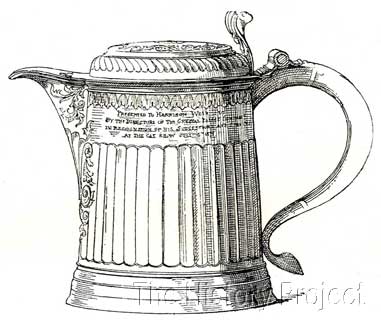 |
Photo by Tom Reeves. Used with permission of the Lewes Town Council, England. RIGHT: Drawing of Silver Tankard by Harrison Weir. Courtesy of The Harrison Weir Collection. |
|
THE AFTERMATH
A more obscure historical fact that is seldom reported, is that there were another FOUR public Cat Shows held between the first Crystal Palace Cat Show of July 1871 and the second Crystal Palace Cat Show held in December 1871. Two of these were held in London, run by entrepreneurial types, keen to 'cash-in' on newly popular and much talked about craze of exhibiting cats competitively. These were similarly followed by another two shows, held in Scotland, one based in Glasgow and one in Edinburgh.
The first privately run London Show was held hot on the heels of The Crystal Palace Show, on August 2nd and 3rd, at the North Woolwich Gardens, by Mr. Holland. Reports vary on the number of entries, but somewhere between 100 and 200 entrants completed for the prize money. Barely four weeks later, a second privately run London Show, billed as a 'Grand Cosmopolitan Prize Cat Show' took place on August 29th and 30th, in the Bedford High Street, Camden-Town, run by Mr. Albert Trotman.
The Glasgow Show, was held at the Burbank Drill Hall on October 3rd and 4th, followed only two days later, on October 6th and 7th, by the Edinburgh Show, which was billed as the 'Scottish Metropolitan Cat Show', which was held in the Royal Gymnasium. This event was organised by Mr. J.M.D. Brown and attracted a whopping 256 entries! Evidence would suggest that one of the judges at both shows, would have been Rev. J. Cumming Macdona, who had officiated as one of the original judges at the first Crystal Palace Cat Show.
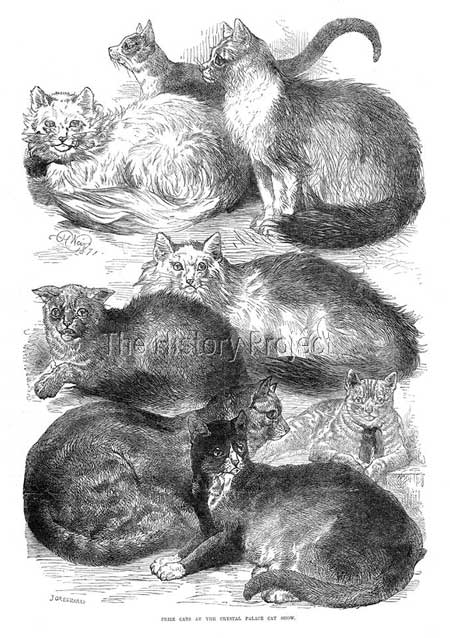 |
Courtesy of The Harrison Weir Collection |
DISQUIET AMONGST CLAIMANTS
But all not was rosy at the completion of both the first Crystal Palace Show. At least not for Mr. Holland, of the North Woolwich Gardens, who quickly claimed that the idea of a Cat Show was in fact his and that he had been planning to hold his show for some time. He appeared miffed by the sudden success of the Crystal Palace Show, indirectly accusing the Crystal Palace Company of somehow stealing his idea.
An article published in 'The Standard' on September 17th, which mentioned Mr. Holland's contribution in introducing baby shows and cat exhibitions to the British public, quickly caught the eye of Mr. Weir. Being a man of considerable principle and integrity, with a considerable knowledge of the history of all types of exhibitions, Weir found himself duty bound to respond to what appeared to him to be stated facts, and to put the matter straight in very unmistakeable terms. His response to the Editor was as follows: -
"TO THE EDITOR OF THE STANDARD
Sir, - In the Standard of Wednesday, September 17th, there is an article entitled "Concerning Barmaids," nearly at the end of which occur these words:- "It is not the first time Mr. Holland has laid society under a debt. History will record that he introduced baby shows and cat competitions to the British public.
Mr. Holland did neither. The first baby show was held at the Surrey Gardens, very many years ago, when, under the direction of Mr. Taylor, and Sullier was there and his great orchestra, by the side of the lake, the prizes were given away, and many shows at other places have been held subsequently.
With regard to the cat show it is more than twelve months ago that, thinking the cat was a most useful, beautiful, though much neglected animal as to its rearing, tending, culture of its instincts, colour, markings, and form, I thought it would raise its status if I could induce some person or persons to hold a cat show, and many months ago the Crystal Palace Company kindly consented on my representations, to hold one in the Palace, at which my brother, Mr. John Jenner Weir, F.Z.S., the Rev. Cumming Macdonne (sic), and myself, acted as judges.
Upon the show becoming a fact and a great success, Mr. Holland put forth a statement that he had conceived the idea of having a cat show, and that the Crystal Palace Company had indirectly got his notion. I wrote and told Mr. Holland that this was not the case, and that it came entirely from me, and that I had neither directly nor indirectly heard of his having thought of such a thing, nor did I know him, nor do I even know where the North Woolwich Gardens are. Yet, I did think it strange, although the Crystal Palace Company had advertised theirs for months in their book, by circular, and also by bills at railway stations and other places, that not until it was a success did I or the company learn his intentions of holding one.
The Crystal Palace was the first cat show, and it was my idea and that of no one else. Another curious thing (to me) was the remarkable likeness of Mr. Holland's prize list to mine, which I drew up for the Crystal Palace Company - almost word for word, with the exception of leaving out two or three classes, even to the price of entry, 3s.6d for each cat, an odd sum, but I had my reasons for it. This and other matters that have been made known to me lead me to form an opinion of Mr. Holland in the matter which I shall keep to myself, but I leave others to draw their own conclusions.
I apologise for troubling you, Sir, on so light a matter, and were it not for my friends I should not do so, though of course I know the unsoundness of Mr. Holland's statement. And yet, after all I am indeed glad to hear there are other cat shows, and I shall be still more pleased to find them becoming general. I am very fond of the cat, both myself and family. At this time I have ten cats of varied colours, and all to me are beautiful and although I keep many birds, pigeons, and poultry, the cats in no way inconvenience them. There are poultry shows now almost everywhere, and why not cat shows? Take, for instance, the quantity of cats kept in London alone. Cat shows will hold out inducements for their improvement in size, form, and colour, and the domestic cat will soon become a domestic pleasure. As I said before, I hope soon to hear of more, and trust they will prove as interesting as the first show held at the Crystal Palace.
HARRISON WEIR, Weirleigh, Kent."
THE TANKARD
There can be little doubt that this statement alone should put to rest any notion about whether, or not, The Crystal Palace Company's July 1871 Cat Show was the first of its kind, and whose idea it was to raise the exhibition standard on behalf of cats. The decision of The Crystal Palace Company to present Weir with the Silver Tankard, as a commemorative token of their appreciation, provides further solid evidence of this view.
The tankard itself is a described as a "William III silver, inverse fluted and chased tankard and cover, made by James Chadwick of London, 1700.The lip of the tankard was added later, probably by Thomas Whipham. Weight: 30 ozs (850 gms)". *
It remained in the possession of Harrison Weir until 1894, when Weirs much beloved brother, John Jenner Weir passed away unexpectedly in his 72nd year. Harrison was so devastated by this loss, that he decided to present a Silver tankard he had won with his prize Pigeons at the Annerley Show of 1856, to the Corporation of Lewes, "in memory of his beloved brother, John Jenner Weir, F.L.S., F.Z.S., F.E.S., born at Lewes, August 9, 1822", which he did on 31st July, 1894. That tankard became part of the Civic Plate and is now known as 'The Jenner Weir Tankard'.
On the same date, Harrison also presented 'The Crystal Palace Tankard' to the Corporation of Lewes, "in token of his love for the old town in which he was born, May 5, 1824." It too became part of the Civic Plate and was henceforth known as 'The Harrison Weir Tankard'.
In April 2017, the author, accompanied by Jeannine Parfitt, visited with the Mayor and Town Clerk at Lewes and was kindly granted permission to take the below photographs for The Harrison Weir Collection and the forthcoming biography of Harrison Weir.
 |
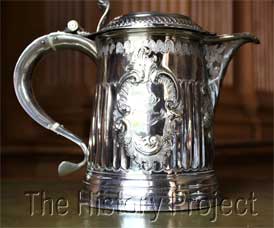 |
Photos by Jeannine Parfitt. Courtesy of The Harrison Weir Collection. |
|
 |
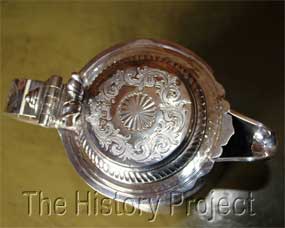 |
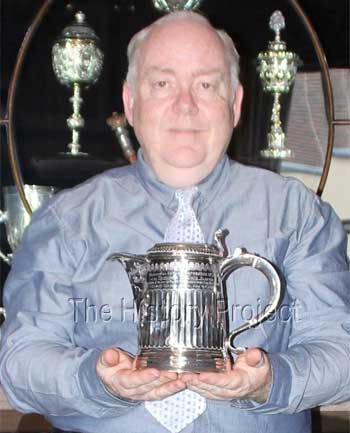 |
Photo by Jeannine Parfitt. Courtesy of The Harrison Weir Collection. |
IN SUMMARY
The Harrison Weir Tankard, may therefore be truly be considered as the forebear of all cat fancy related trophies and memorabilia. It quite singularly acknowledges the birth or dawning of the era of The Cat Fancy, and that this momentous day and its success was largely due to the ideas and efforts of one very far-sighted cat lover, artist and naturalist, in the person of Harrison William Weir.
References/Credits:
- Line Drawing from Our Cats, by Harrison Weir, published by R.Clements & Co., Tunbridge Wells, 1889.
- Photo by Tom Reeves (courtesy of the Lewes Town Council).
- Prize Cats at the Crystal Palace Cat Show, drawn by Harrison Weir, published in the 'Illustrated London News', July 22nd, 1871.
- Letter to the Editor, from The Standard, published September 19th, 1871.
- Quoted from the 'Civic Insignia and Plate of Lewes Town Council'. (Courtesy of the Lewes Town Council).
- 2017 Photos of The Harrison Weir Tankard, by Jeannine Parfitt, Oxford.
- Text: copyright to John G Smithson. (Revised 2018)
Home | Cats | Gallery | Clubs | People | Artifacts | Articles | Updates | Contact Us
©The CFA Foundation, Inc and The Harrison Weir Collection
This project is a collaboration between The CFA Foundation, Inc. and The Harrison Weir Collection.
All material on this site is copyrighted and may not be printed or reproduced, in any form, without the express written consent of the collaborators.